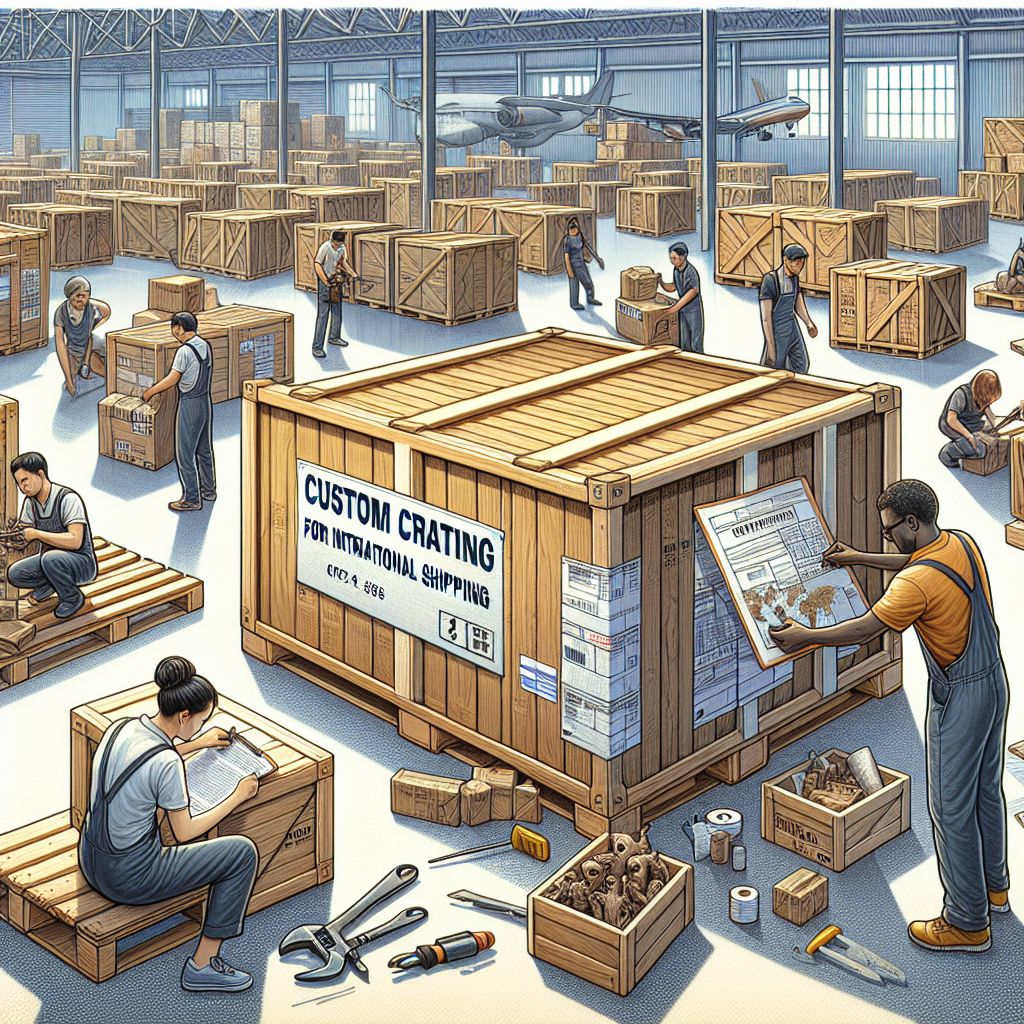Table of Contents
Key Takeaways
-
Custom crating is essential for protecting high-value and fragile items during transport.
-
Different items require different crating solutions, tailored to their specific needs.
-
Quality materials and expert design are key to creating a secure crate.
-
The crating process includes evaluation, design, and packing, ensuring items are well-protected.
-
Choosing the right custom crating service can make the difference between a damaged item and one that arrives in perfect condition.
Why Custom Crating is Non-Negotiable for Your Valuables
Imagine this: You’ve just sold a piece of art that’s not only expensive but also close to your heart. It needs to travel across the globe to its new owner. Now, would you just wrap it in bubble wrap and hope for the best? Absolutely not. That’s where custom crating services step in. They’re like the superheroes of the shipping world, swooping in to protect your valuables from the perils of transportation.
Custom crating isn’t a luxury; it’s a necessity. Because when it comes to shipping high-value and fragile items, the stakes are just too high. A standard box might suffice for your everyday items, but for the things that are irreplaceable or carry a hefty price tag, you need a fortress, not just a container.
Defining Custom Crating and Its Importance
So, what exactly is custom crating? It’s the process of building a protective wooden crate specifically designed to secure and shield your item during transit. This isn’t your average cardboard box; it’s a sturdy, tailor-made solution that considers the item’s size, weight, fragility, and value.
Why is it so important? Well, think about the journey an item takes from point A to point B. It’s not just about getting from one place to another. It’s about braving rough handling, jostling, and the extreme conditions it might encounter along the way. Custom crating ensures that your item is cocooned in safety, no matter what it faces.
Types of Items That Demand Custom Crating
Not all items need custom crating, but for some, it’s non-negotiable. Let’s take a quick look at what kinds of treasures we’re talking about:
-
Artwork: Paintings, sculptures, and installations that are often one-of-a-kind and extremely delicate.
-
Antiques: Heirloom furniture or vintage collectibles that are not just valuable but also irreplaceable.
-
Electronics: High-end audio equipment, servers, or other technology that’s sensitive to shocks and vibrations.
-
Industrial equipment: Machinery that’s both heavy and intricate, requiring solid protection to maintain precision.
-
Musical instruments: From grand pianos to rare violins, these items are both fragile and often steeped in history.
These items are just the tip of the iceberg. If you’re unsure whether your item falls into this category, it’s always better to err on the side of caution and opt for a custom crate.
Create a Fortress Around Your Fragile Goods
Creating a fortress around your fragile goods is not just about slapping together some wooden panels. It’s a craft. A custom crate is designed to fit your item like a glove and protect it against all odds.

Materials Used in Custom Crating
The materials used in custom crating are the foundation of its strength. Here’s what you can expect:
-
Wood: Often, the wood used is plywood or lumber, which provides a sturdy frame and can be heat-treated for international shipping regulations.
-
Cushioning: Inside the crate, materials like foam inserts, bubble wrap, or packing peanuts keep your item snug and absorb shocks.
-
Reinforcements: For particularly heavy or valuable items, additional reinforcements, such as steel brackets, might be used.
These materials are chosen for their durability and ability to protect. It’s not about cutting corners; it’s about ensuring safety in every layer.
Customization Options for Optimal Security
When it comes to customization, the options are vast. Here’s what a crating service might offer:
-
Custom sizing to the exact dimensions of your item.
-
Options for waterproofing and vapor barriers to protect against the elements.
-
Specialized compartments for items with multiple parts.
-
Locks and seals for added security during transit.
These options aren’t just add-ons; they’re carefully considered features that ensure your item’s journey is a safe one.
Packing Techniques to Shield Your Items
Now, let’s dive into the heart of the matter – packing techniques. It’s not just about filling space; it’s about strategic placement and protection. Here’s how the pros do it:
-
Every item is wrapped individually, often with multiple layers of protection.
-
Void spaces are filled with cushioning materials to prevent any movement.
-
Heavy-duty straps might be used to secure the item within the crate, ensuring it stays put.
These steps are critical because even the smallest shift inside the crate can lead to damage. Remember, it’s not just about getting there; it’s about arriving as if the journey never happened.
Handling With Care: The Transportation Phase
Once your item is safely encased in its custom crate, the next step is handling and transportation. This phase is all about expertise and experience. Professional crating services work closely with freight carriers to ensure that your items are loaded, transported, and unloaded with the utmost care. They understand the significance of ‘fragile’ labels and treat your items accordingly.
Moreover, they’ll coordinate with logistics providers to choose the best route and mode of transport, be it air, sea, or land. This decision is based on factors like the item’s urgency, the destination’s accessibility, and the overall cost. Rest assured, your valuables are in good hands.

Crating Services: When Standard Boxes Just Won’t Cut It
So, you might wonder, why can’t I just use a standard box with some extra padding? The answer is risk. Standard boxes offer limited protection and are prone to crushing, tearing, and water damage. When it comes to irreplaceable or costly items, that’s a gamble you don’t want to take.
The Limitations of Conventional Packaging
Conventional packaging is designed for conventional items. It’s mass-produced to fit the ‘one-size-fits-most’ model. But your valuables are not ‘most items.’ They have unique needs that off-the-shelf solutions simply cannot meet. The limitations are clear:
-
Standard boxes have weight limits that might not be suitable for heavier items.
-
They’re not always stackable, which is a problem in a cargo hold or shipping container.
-
The materials used in standard packaging may not withstand extreme conditions or long journeys.
Custom crating, on the other hand, is designed to overcome these limitations, providing a tailored, secure environment for your item.
Comparing Crating vs. Boxing for Delicate Deliveries
Let’s break it down further. Here’s a comparison between crating and boxing:
|
Aspect |
Crating |
Boxing |
|---|---|---|
|
Material Strength |
Sturdy wood capable of supporting heavy loads |
Cardboard that may compress under weight |
|
Customization |
Measured and built to fit your item’s dimensions |
Limited sizes and shapes, often resulting in wasted space |
|
Security |
Locks and seals available for added protection |
No secure locking mechanisms |
|
Protection |
Multiple layers and shock-absorbing materials |
Basic padding, if any, with limited shock absorption |
|
Durability |
Designed to withstand harsh conditions and multiple trips |
Often single-use and susceptible to environmental damage |
When you compare the two side by side, it’s clear why custom crating is the superior choice for delicate deliveries.
Getting Real: Real-World Success Stories of Custom Crating
Stories of triumph always bring the point home. Let’s look at a couple of real-world examples where custom crating made all the difference.
Artwork Arrives Intact: A Case Study
A gallery in New York needed to ship a large, fragile glass sculpture to an international art fair. The piece was not only expensive but also the centerpiece of their exhibit. They opted for a custom crate with specialized cushioning and a climate-controlled environment. The sculpture arrived without a scratch, and the gallery reported record sales and exposure as a result.
The Safe Journey of Heirloom Antiques
A family heirloom, a 19th-century grandfather clock, had to be transported from London to a descendant’s home in San Francisco. The clock’s intricate mechanics and historical value made it irreplaceable. A custom-built crate with reinforced corners and a foam-lined interior was used, and the clock arrived in perfect working order, ready to keep time for another century.
These stories aren’t just about successful shipments; they’re about the peace of mind that comes with knowing your treasures are well-protected. And that’s priceless.
Innovations in crating are changing the game for shipping delicate and high-value items. With advancements in materials and technology, custom crating services are now more accessible and effective than ever before.
Technology Aiding Custom Crating Practices
Technology plays a significant role in the evolution of custom crating. From 3D modeling software that helps design the perfect crate to tracking systems that allow you to monitor your item’s journey, the integration of tech ensures your items are not just safe, but also accounted for every step of the way.
For instance, with the help of 3D printing, custom padding and supports can be created to fit every contour of your item, ensuring maximum protection. These innovations are not just cool; they’re your item’s best friend on a bumpy ride.
Sustainable Materials in Crating
As we become more environmentally conscious, the crating industry is keeping up. Sustainable materials are now being used to create crates that are not only strong but also kinder to the planet. Recycled wood, biodegradable packing peanuts, and even mushroom-based cushioning are making their way into the custom crating world.
Choosing a crating service that uses sustainable materials doesn’t just help the environment; it sends a message that you care about the planet as much as you do about your possessions.
FAQs
Got questions? You’re not alone. Here are some frequently asked questions about custom crating services to help you make the best decision for your items.
How Do I Know If My Item Needs Custom Crating?
If you’re shipping something that’s either too large, too heavy, too fragile, or too valuable for standard boxes, then custom crating is the way to go. If you’re still not sure, think about the item’s replacement cost and sentimental value. Can you afford to lose it or have it damaged? If not, then custom crating is a must.
Is Custom Crating Affordable or Cost-Prohibitive?
When it comes to protecting your valuables, custom crating is an investment. The cost will vary depending on the size, material, and complexity of the crate, but it’s typically more affordable than you might think. Considering the potential loss or damage without proper protection, custom crating often proves to be cost-effective in the long run.

Can I Request Custom Crating for International Shipping?
Absolutely! Custom crating is ideal for international shipping because it meets various international standards and regulations. Crates can be built to comply with ISPM-15 for wood packaging, and with proper materials, they can protect your items from humidity, temperature changes, and long transit times.
-
Ensure the crating service is familiar with international shipping regulations.
-
Ask if they provide heat-treated wood, which is often required for international shipments.
-
Consider additional protection like vapor barriers for sea shipments.
How Long Does the Custom Crating Process Take?
The time it takes to create a custom crate can vary. It usually depends on the complexity of the design and the availability of materials. Generally, you can expect the process to take anywhere from a few days to a couple of weeks. Planning ahead is crucial, especially if you have a tight shipping schedule.
What Are the Insurance Implications for Crated Items?
One of the many benefits of custom crating is the potential for better insurance coverage. Because your item is more secure, it’s less likely to be damaged, which can result in lower premiums. Always discuss insurance options with your crating service provider and ensure that your items are adequately covered.
In conclusion, custom crating services are not just an added expense; they’re a necessary safeguard for your high-value and fragile items. Whether you’re an artist, collector, or simply moving precious belongings, custom crating offers the peace of mind that no standard box can provide. And remember, the right crating service can make all the difference. So, when it comes to protecting your valuables, don’t hesitate to reach out to a professional custom crating service. Your items deserve the best protection available, and that’s exactly what custom crating aims to provide.



